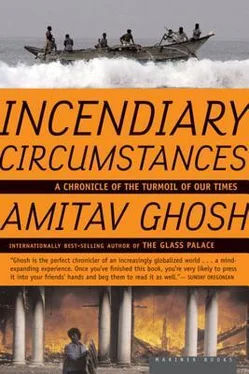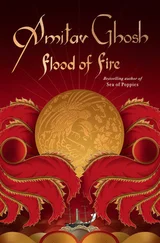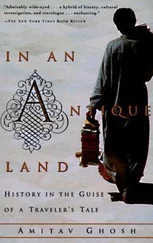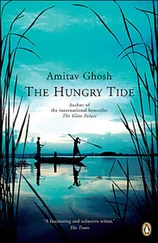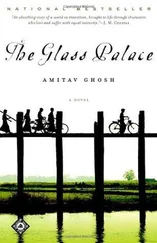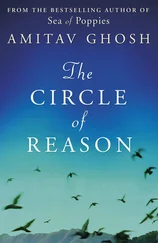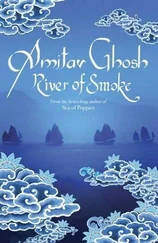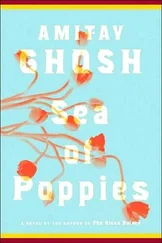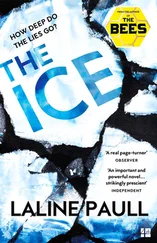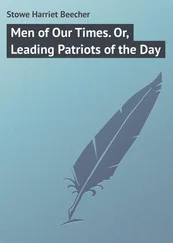Two officers marched in, and Fernandes turned to talk to them. It was clear at a glance that despite Fernandes's sandals and rumpled clothes and the officers' heel-clicking starchiness, there was a genuine warmth between him and the soldiers. It occurred to me that Fernandes too wore a kind of uniform. It was a statement of simplicity.
The room was large but dank. Two pictures hung high on a wall. One was a portrait of Mahatma Gandhi; the other was a photograph of the ruins of a church in Hiroshima. It was probably here, at this desk, under these pictures, that Fernandes had deliberated on the tests of May 11.
I thought back to India's first atomic test. I was eighteen, in my second year at Delhi University. The voices of dissent were few; all the major political parties, right and left alike, came out in support. Fernandes was one of the very few political figures who openly criticized the test. For those such as myself, people who were opposed to nuclear armaments in an instinctive, perhaps unreflective way, Fernandes became a kind of beacon.
It was lunchtime, and Fernandes led the way to a spiral staircase. I spotted a small, simian figure observing us from a landing. I stopped, startled. It was a monkey, a common rhesus, with a muddy-brown mantle and a bright red rump. The animal stared at me calmly, unalarmed, and then went bounding off down a corridor.
"Did you see that monkey?" I said.
Fernandes laughed. "Yes. There's a whole troop living on this staircase."
"Sometimes," one of his aides whispered, "they attack the generals."
At lunch I said to Fernandes, "Are you comfortable with the recent nuclear tests? I ask you this because I have read your antinuclear writings and seen you at peace marches."
"I was opposed to the bomb from day one till the nineteenth of July, 1996," Fernandes said. On that day, the Lok Sabha was debating the Comprehensive Test Ban Treaty banning further tests. "In these discussions there was one point of unanimity: that we should not sign this treaty. I went through deep anguish — an atom bomb was morally unacceptable. But why should the five nations that have nuclear weapons tell us how to behave and what weapons we should have? I said we should keep all our options open — every option." The implication was that even then, he hadn't been able to endorse nuclear weapons.
After lunch, as he was rising to leave, Fernandes told me that he was scheduled to visit military installations in the embattled state of Kashmir. From there, he planned to fly farther north, to Ladakh and the Siachen Glacier, in the Karakoram Mountains. Across these snows, at altitudes of up to 22,000 feet, Indian and Pakistani troops have been exchanging fire regularly for fourteen years. The trip was to be a tour of inspection, but Fernandes would also address some political meetings. If I wanted to join him, he said, I should tell his office.
On the morning of August 24, I boarded an Indian Air Force plane with Fernandes and his entourage. The plane was a twin-engine AN-32, an elderly and unabashedly functional craft of Soviet manufacture.
We stopped for lunch at a large military base in eastern Kashmir. I found myself sharing a table with several major generals and other senior officers. I was interested to learn these senior officers' views of the nuclear tests, but I soon discovered that their curiosity exceeded mine. Did I know who was behind the decision to proceed with the tests? they asked. Who had issued the orders? Who had known in advance?
I could no more enlighten them than they could me. Only in India, I thought, could a writer and a tableful of generals ask each other questions like these. It was confirmation, at any rate, that the armed forces' role in the tests had been limited.
The views of the military personnel were by no means uniform. Many believed that India needed a nuclear deterrent; some felt that the tests had resulted in security benefits for both India and Pakistan — that the two countries would now exercise greater caution in their frequent border confrontations.
But others expressed apprehensions. "An escalation of hostilities along the border can happen very easily," a major general said to me. "It takes just one officer in the field to start it off. There's no telling where it will stop."
None of the generals, I was relieved to note, appeared to believe that nuclear weapons were harmless icons of empowerment. In the light of my earlier conversations, there was something almost reassuring in this.
After lunch we went by helicopter to Surankote, an army base in the neck of territory that connects Kashmir to India. It was set in a valley, between steep, verdant hills. The sunlight glowed golden and mellow on the surrounding slopes. We were whisked off the landing pad and taken to the base. I found myself riding in a vehicle with a young major.
"What's it like here?" I said.
"Bad." He laughed. "Bordering on terrible." The Pakistani frontlines were just a few miles away, he explained. It took just a day to walk over the hills.
At the base there was a crowd of a few hundred people. Fernandes had mounted a podium with several other politicians and local dignitaries. Behind them were green hills capped by clouds.
The major pointed at the hills. "While we're standing here talking, there are half a dozen operations going on in those hills, right there."
He led me aside. "Let the politicians talk," he said. "I'll show you what's happening here if you want to know." We went into a tent and the major seated himself at a radio set. "This is where we listen to them," he said. He scanned the wavelengths, tuning in to several exchanges. "Listen," he said, turning up the volume. "They're speaking Punjabi, not Kashmiri. They're mercenaries who've signed up on two-year contracts. They're right there, in those hills."
The voices on the radio had a slow, dreamlike quality; they were speaking to each other unhurriedly, calling out cheerful greetings in slow-cadenced rural Punjabi.
As we were leaving the tent, the major darted suddenly into a group of journalists and took some rolls of film from a photographer. "I don't know what they've taken pictures of," he said. "I can't trust anyone here."
We walked back to listen to the speeches. "The politicians talk so well," the major said. "But what we have is a war. Does anyone know that? Does anyone care?"
The next day we flew to Leh, the principal town in the Himalayan region of Ladakh. Ladakh is only a few hundred miles from the valley of Kashmir, but near Leh, in the east, it is a world apart, a niche civilization — a far outpost of Buddhist culture which has flourished in a setting as extreme, in climate, altitude, and topography, as that of Tibet.
Leh is at 11,500 feet. On landing, we were handed pills to prevent altitude sickness and warned of short-term memory loss. In the afternoon, driving toward the Siachen Glacier, we went over the 18,300-foot Khardung Pass. A painted sign announced this to be the world's highest motorable road. Ahead lay the Karakoram Range. Among the peaks in this range is the 28,250-foot K2, Mt. Godwin-Austen, the second highest mountain in the world.
The landscape was one of lunar desolation, with electric-blue skies and a blinding sun. Great sheets of glaciated rock rose sheer out of narrow valleys: their colors were the unearthly pinks and mauves of planetary rings and stellar moons. The mountains had sharp, pyramidal points, their ridges honed to fine, knifelike edges. Below, along the valley floors, beside ribbonlike streams, were trees with silver bark. On occasional sandbanks, dwarfed by the vastness of the landscape, were tidy monasteries and villages.
The Siachen Glacier is known as the Third Pole. Outside of the polar wastelands, there is perhaps no terrain on earth that is less hospitable. There are no demarcated borders. Kashmir has what was once called the cease-fire line, which serves as a de facto border, but it stops short of this region, ending at a point on the map known as NJ 9842. The line was created in 1949, after the first war between India and Pakistan. At the time, neither India nor Pakistan conceived of needing to extend it into the high Karakorams, beyond NJ 9842. "No one had ever imagined," a Pakistani academic told me later, when I visited Lahore, "that human beings would ever wish to claim these frozen places."
Читать дальше
